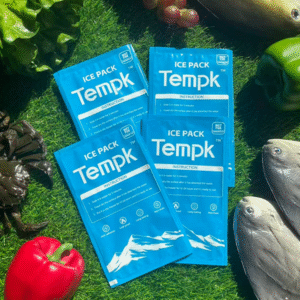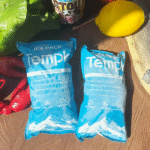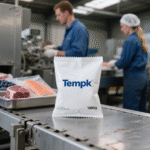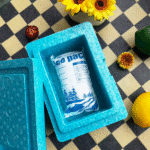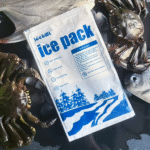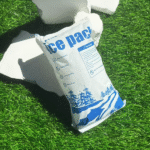¿Cómo garantizan las bolsas de hielo seco un envío de carne seguro y eficiente? 2025?
Cuando se trata de enviar carne, Mantener la temperatura correcta es esencial para preservar tanto la seguridad como la calidad.. Las bolsas de hielo seco son la solución preferida para muchas empresas de la industria de la cadena de frío., Garantizar que los productos cárnicos lleguen a su destino congelados y frescos.. Este artículo profundiza en la ciencia detrás del hielo seco., sus ventajas sobre los métodos tradicionales, y cómo las empresas pueden optimizar sus prácticas de envío utilizando esta herramienta de refrigeración esencial.
-
Como Las bolsas de hielo seco mantienen la carne congelada durante el envío?
-
¿Cuáles son las mejores prácticas y normas legales para enviar carne con hielo seco en 2025?
-
¿Cuánto hielo seco debería utilizar para el envío de carne??
-
¿Qué innovaciones y tendencias están dando forma a las soluciones de hielo seco en la cadena de frío??
¿Cómo mantienen las bolsas de hielo seco la carne congelada durante el envío??
El hielo seco es dióxido de carbono en su forma sólida., sublimarse directamente en gas sin pasar por un estado líquido. Esta propiedad única hace que el hielo seco sea increíblemente eficiente para mantener temperaturas bajo cero., que es esencial para el envío de productos cárnicos como la carne de res, aves de corral, y mariscos. Las bolsas de hielo seco proporcionan un efecto refrescante que puede durar desde 24 a 72 horas, dependiendo de las condiciones.
¿Cómo mantiene el hielo seco la temperatura adecuada para el envío de carne??
-
Tiempo de enfriamiento extendido: El hielo seco mantiene la carne congelada durante períodos prolongados sin necesidad de refrigeración. El efecto frío que produce es ideal para envíos de larga distancia..
-
Sin residuos líquidos: A diferencia del hielo normal, que se derrite en el agua, El hielo seco sublimate, asegurando que no haya residuos líquidos que puedan causar contaminación o empapado en el empaque de la carne.
-
Temperatura estable y constante: La capacidad del hielo seco para mantener una temperatura baja constante evita las fluctuaciones de temperatura que podrían provocar deterioro y crecimiento bacteriano., Garantizar que los productos cárnicos se mantengan frescos..
| Método de enfriamiento | Rango de temperatura | Duración | Caso de uso ideal |
|---|---|---|---|
| Paquetes de hielo seco | -78.5°C (-109.3°F) | 24–72 horas | Envío de carne a larga distancia |
| Paquetes de gel | 0°C (32°F) | 12–24 horas | Envíos de corta distancia |
| Paquetes de hielo | 0°C (32°F) | 6–24 horas | Artículos menos sensibles a la temperatura |
¿Por qué debería elegir hielo seco para el envío de carne??
1. Mantener la frescura para envíos prolongados
Para que la carne se mantenga fresca durante envíos largos, es crucial evitar cualquier fluctuación de temperatura. El hielo seco ayuda a garantizar que el producto permanezca congelado., especialmente en envíos internacionales o entre países. sin eso, los productos cárnicos se estropearían, poniendo en riesgo la salud y la calidad. El hielo seco ofrece el frío constante necesario para que la carne se mantenga fresca..
2. Prevención del crecimiento y deterioro bacteriano
La carne es muy susceptible al crecimiento de bacterias., y estos microorganismos prosperan en temperaturas más cálidas. El hielo seco mantiene temperaturas muy por debajo del punto de congelación, Minimizar eficazmente la actividad bacteriana y garantizar que la carne se mantenga segura para el consumo..
3. Rentable para envíos de larga distancia
Aunque el hielo seco puede ser más caro que los paquetes tradicionales de hielo o gel., su capacidad para mantener una consistencia, la baja temperatura durante períodos prolongados lo hace rentable para el envío a larga distancia. Menos pérdidas relacionadas con el deterioro y menores interrupciones en la temperatura se traducen en menos devoluciones y una mayor satisfacción del cliente..
¿Cuánto hielo seco debería utilizar para el envío de carne??
La cantidad de hielo seco necesaria depende de varios factores, incluyendo el peso de la carne, la duración del tránsito, y la calidad del aislamiento del embalaje..
Pautas generales:
-
1–2 libras de hielo seco por 5 libra de carne para viajes cortos a medianos.
-
5–10 libras de hielo seco por cada 10 a 15 libras de alimentos congelados por cada período de 24 horas.
-
Incluya siempre un 20-30% buffer para tener en cuenta retrasos y fluctuaciones de temperatura, particularmente en los meses más cálidos.
Ejemplo de cálculo de hielo seco:
Por un 10 Envío de libras de carne congelada con un tiempo de tránsito de 2 días., necesitarías aproximadamente 12 libra de hielo seco:
-
Hielo seco = 10 libras × 1.1 × 2 × 1.25 = 12.4 lb
Esto asegura que la carne permanezca congelada durante todo el período de tránsito.. Asegúrese de probar los envíos en condiciones similares antes de ampliarlos..
¿Qué innovaciones y tendencias están dando forma a las soluciones de hielo seco para el envío de carne? 2025?
La industria de la logística de la cadena de frío está evolucionando rápidamente. En 2025, Varias tendencias están dando forma a la forma en que se utiliza el hielo seco para el envío de carne.:
1. Gestión de temperatura impulsada por IA
Algoritmos sofisticados y sensores de IoT ahora se integran en la logística de la cadena de frío. Estos dispositivos permiten el seguimiento de la temperatura en tiempo real, Ayudar a las empresas a ajustar las cantidades de hielo seco en función de las condiciones en tiempo real.. Esto minimiza el deterioro y garantiza que la carne se mantenga dentro del rango de temperatura requerido durante el tránsito..
2. Producción de hielo seco sostenible
A medida que aumenta la demanda de prácticas ecológicas, Las innovaciones en la producción de hielo seco se centran en la sostenibilidad.. Se están utilizando técnicas de captura de carbono para producir “carbono neutro” hielo seco, mientras que los materiales aislantes reutilizables y reciclables están ganando terreno.
3. Sensores de embalaje inteligentes
Nuevas soluciones de embalaje inteligentes integran sensores de temperatura y ubicación, Permitir a las empresas controlar el estado de sus envíos.. Si la temperatura sube por encima de un umbral establecido, El sistema puede provocar la liberación de refrigerante adicional o redirigir el envío para evitar su deterioro..
Mejores prácticas para enviar carne con hielo seco en 2025
-
Capas y aislamiento: Utilice un método "sándwich", colocar bloques de hielo seco en la parte inferior y superior de la carne, con una barrera entre el hielo y el producto para evitar el contacto directo. Asegúrese de que el paquete esté bien aislado para reducir el consumo de hielo seco..
-
Ventilación: Siempre permita una ventilación adecuada en el embalaje para evitar la acumulación de gas dióxido de carbono.. El hielo seco se sublima en gas, y sin ventilación adecuada, el paquete podría romperse.
-
Etiquetado: Etiquete claramente el envío con etiquetas de "Perecedero" y "Mantener congelado"., y garantizar el cumplimiento de las regulaciones específicas del transportista con respecto a los envíos de hielo seco..
2025 Normas para el envío de carne con hielo seco
A medida que evolucionan las regulaciones sobre el envío de productos perecederos, es importante mantenerse actualizado sobre los requisitos. El Y 1845 La etiqueta es obligatoria para envíos aéreos que contienen hielo seco., y las regulaciones limitan la cantidad de hielo seco permitida en cada paquete según el transportista y el método de envío..
Consideraciones regulatorias clave:
-
USPS permite que 5 lb de hielo seco para envíos aéreos y más para envíos terrestres.
-
Fedex permite que 200 kg de hielo seco por paquete para envíos aéreos.
-
Asegúrese siempre de que el paquete esté ventilado., e incluir la documentación necesaria para envíos aéreos.
Preguntas comunes sobre las bolsas de hielo seco para el envío de carne
Q1: ¿Cuánto tiempo puede el hielo seco mantener congelada la carne durante el envío??
El hielo seco generalmente dura 24 a 72 horas, dependiendo de la cantidad utilizada, tamaño del paquete, y condiciones de envío. Para envíos más largos, Controle los niveles de hielo seco y reemplácelo si es necesario..
Q2: ¿Es seguro el hielo seco para enviar carne??
Sí, El hielo seco es seguro para enviar carne cuando se usa correctamente.. Asegúrese de que el paquete permita una ventilación adecuada y que el hielo seco se manipule con cuidado para evitar congelación o acumulación de presión..
Q3: ¿Puedo reutilizar bolsas de hielo seco para el envío de carne??
No, El hielo seco no se puede reutilizar., ya que se sublima durante el tránsito. Sin embargo, El embalaje utilizado para el hielo seco se puede reutilizar para futuros envíos..
Conclusión y recomendaciones
En resumen, Las bolsas de hielo seco son una herramienta indispensable en la industria del transporte de carne., proporcionando una solución confiable y rentable para mantener la cadena de frío. Ayudan a las empresas a garantizar la seguridad y la calidad de sus productos., reducir el deterioro, y cumplir con las normas de seguridad.
Siguientes pasos:
Para empresas que envían carne, considere implementar bolsas de hielo seco para envíos de larga distancia. Evalúe sus métodos de embalaje, Calcule la cantidad necesaria de hielo seco en función de sus productos.’ necesidades, y manténgase informado sobre actualizaciones regulatorias e innovaciones en tecnología de cadena de frío..
Acerca de Tempk
Tempk se especializa en soluciones de cadena de frío para la industria cárnica, ofreciendo bolsas de hielo seco, refrigeradores aislados, y opciones de envío sostenibles. Nuestros productos garantizan que sus productos cárnicos permanezcan congelados, fresco, y cumple con los estándares de la industria.
Póngase en contacto con Tempk hoy para obtener soluciones personalizadas de cadena de frío y asesoramiento de expertos para mejorar su proceso de envío de carne.!






